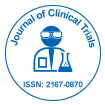
Journal of Clinical Trials
Open Access
ISSN: 2167-0870

ISSN: 2167-0870
Editorial - (2013) Volume 3, Issue 4
Cell proliferation requires active nutrient uptake, synthesis of nucleic acids, proteins, and lipids and production of ATP. It is thus not surprising those oncogenes that drive cell proliferation also drives metabolic regulation, either directly or indirectly. Metabolic regulation in cells is dictated by the availability of nutrients. One of the hallmarks of rapidly growing tumor cells is their ability to sustain high rates of glycolysis for ATP generation, irrespective of oxygen availability - a phenomenon known as the Warburg effect [1,2]. This unique ability of tumor cells enables them to survive better under hypoxia, a condition often encountered during tumor progression. Since the ability to adapt and survive under hypoxia is unique to tumor cells, it opens up new opportunities for therapeutic intervention. Although inhibitors of cellular proliferation that blocks or terminates DNA synthesis or that cross-links or fragments DNA have emerged as some of the classic anticancer agents, these drugs are directed toward normal cellular proliferation processes and therefore lack selectivity for neoplastic cells over proliferating normal cells. The same is true of classic inhibitors of intermediary metabolism, many of which are enzyme transition state analogues.
Since its discovery more than three decades ago as a viral oncogene (v-MYC) in the acutely transforming MC29 virus, MYC has emerged as one of the most commonly deregulated oncogene in human cancers. MYC is a basic helix-loop-helix transcription factor that forms a heterodimer with another protein called MAX, and binds DNA upstream of target genes [3]. MYC frequently accumulates in many cancers and has been shown to play a key role in tumor progression [3]. Apart from being frequently deregulated in many cancers, MYC appears to function downstream of most other oncogenes, suggesting that MYC acts as a signaling hub and a key downstream effecter. The MYC oncogene has also been shown to play an important role in cancer cell metabolism. Many recent studies have revealed a strong link between MYC-dependent altered cellular metabolism and tumorigenesis [1,2]. MYC target genes include those involved in the ribosome and mitochondrial biogenesis, regulation of glucose, glutamine and nucleotide metabolism, and DNA replication [1,2]. MYC has also been shown to be involved in hypoxic adaptation. Glycolytic genes such as lactate dehydrogenase A and glutaminase are regulated by MYC through direct and indirect mechanisms. MYC overexpression in cancers could therefore concurrently drive aerobic glycolysis and/or oxidative phosphorylation depending on the context of the tumor microenvironment to provide sufficient energy and anabolic substrates for cell growth and proliferation. The dependence of cancer cells on MYC to fulfill their metabolic demands and the role of MYC as a final effector in cancer cells has made it an attractive cancer therapeutic target.
The potential of MYC inhibition as an anti-tumor therapeutic strategy has been highlighted by many studies where MYC inhibition was shown to halt tumor progression in mouse models. However, efforts to develop drugs that target MYC have largely proven unsuccessful, partly due to the lack of an obvious target-binding site on the protein. Recently, new approaches have emerged that have shown promise in selectively regulating the function on this elusive cancer target. Rapid and potent abrogation of MYC gene transcription by small molecule inhibitors of the BET family of chromatin adaptors is one such strategy. Disruption of BET bromodomain-promoter interactions leading to subsequent reduction of MYC transcript and protein levels resulted in G1 arrest and extensive apoptosis in a variety of leukemia and lymphoma cell lines [4]. Another emerging strategy is the use of a mutant basic helix-loop-helix zipper domain, Omomyc, which dimerizes with MYC and sequesters it in complexes thereby preventing binding of MYC to the E-box. Thus, by acting as a potential dominant negative, Omomyc can reverse tumorigenesis in cancers driven by high-levels of MYC [5]. Small molecules such as 10058- F4, a characterized c-MYC/Max inhibitor, that targets the MYC/Max interaction has also been shown to lead to cell cycle arrest, apoptosis, and neuronal differentiation [6].
Since MYC acts a major regulator that controls the expression of nearly 15% of human genes there exist the concern that long-term treatment using the strategies aimed at total loss of MYC function might cause significant and uncontrollable side effects. An alternative strategy would be to use peptides and peptido-mimetics that would specifically interfere with protein-protein interaction between MYC and specific interacting proteins. Although technically challenging, if successful, this strategy would offer the advantage of specifically disrupting specific MYC function without impairing its general role in growth and metabolism. Such a strategy can also be used to fine tune MYC levels in cells. The stability of MYC in cells is regulated by various post-translational modifications. Phosphorylation at different sites influences its turnover and steady state levels [7,8]. Thus by designing peptides that would disrupt the interaction of MYC with these specific protein kinases, one could in theory regulate its turnover. This unique ability of his strategy (if successful) to fine tune MYC levels in cells as opposed to a ‘complete loss of function’ based strategy would help overcome the possible side effects of the later strategy.